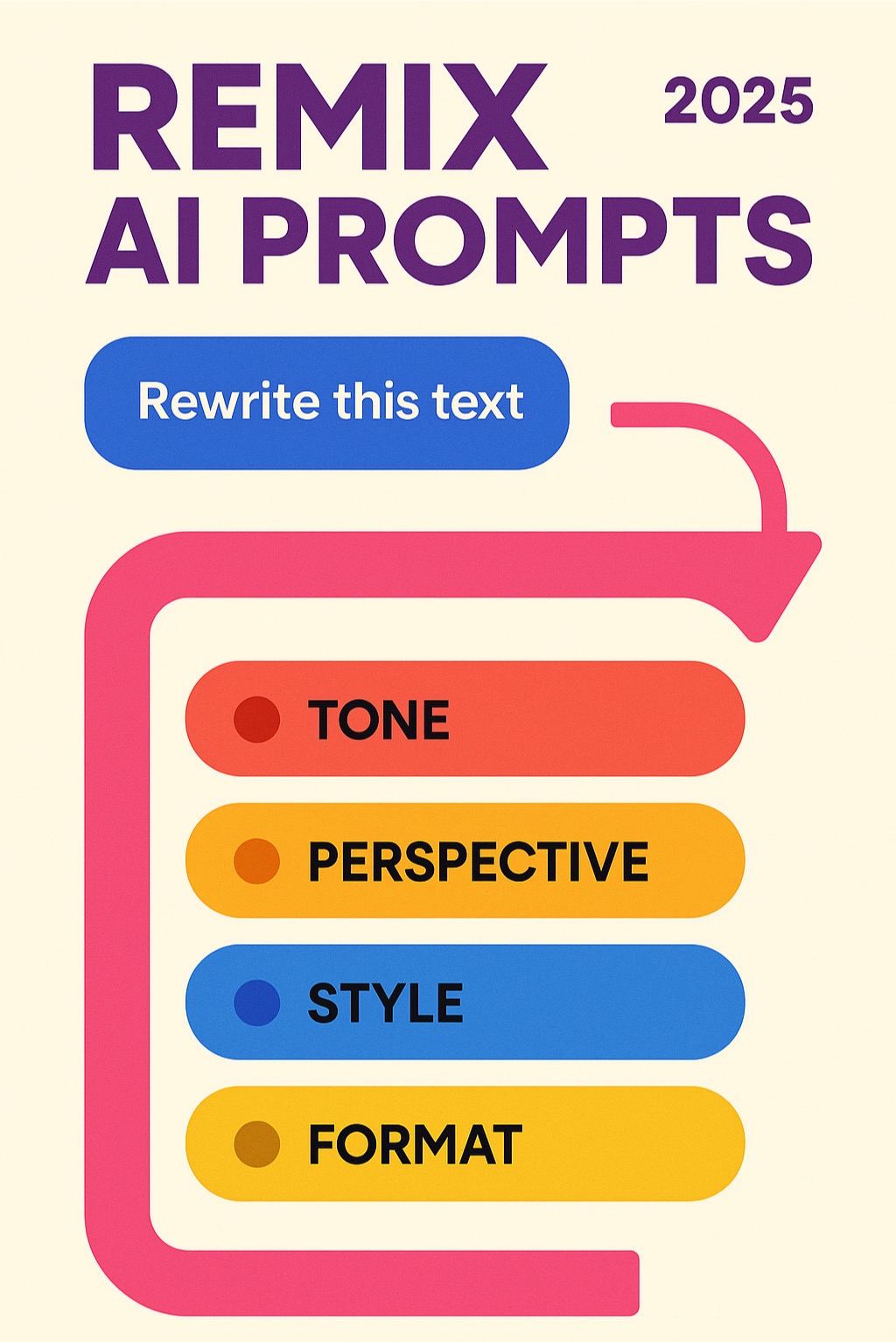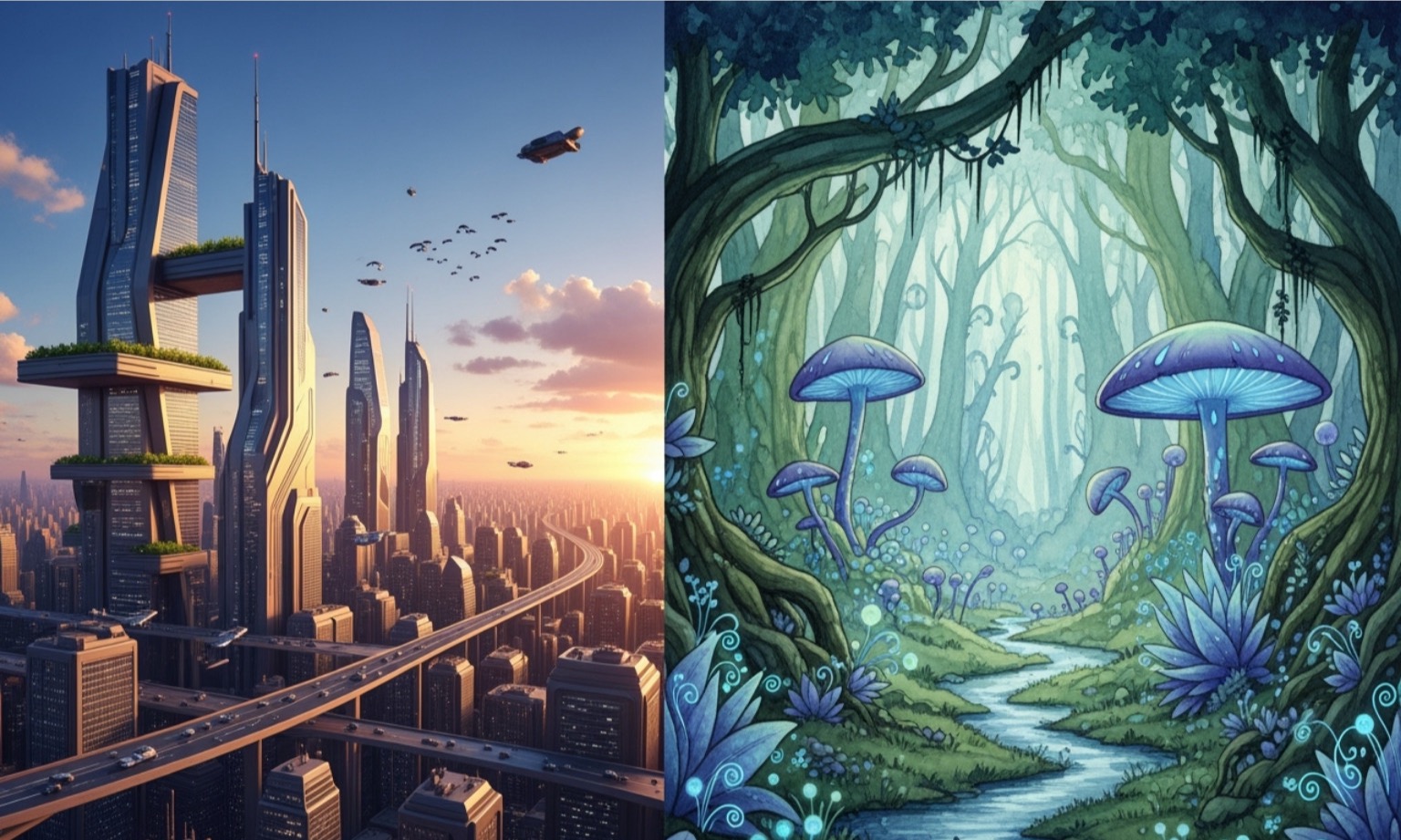Unleash Your Inner DJ: Remixing AI Prompts for Next-Level Creations
Why Remixing AI Prompts is the Secret to Better Results.

Remix AI prompts are the key to opening up truly creative and powerful AI outputs. Instead of starting from scratch, remixing lets you take a working prompt and evolve it into something better—like a DJ creating new music from existing tracks.
Remixing involves taking an existing AI prompt and modifying specific elements (like the subject, style, or tone) while keeping the core structure. This builds on a proven foundation, saving time and delivering superior results for image generation, text creation, and content variation.
Most AI users get stuck in the "rewrite" trap. Asking an AI to "rewrite" something often yields a near-identical copy with just a few words shuffled. As one expert notes, "The word 'rewrite' can often feel restrictive." Remixing, however, is about making targeted, meaningful changes.
Research shows that even subtle tweaks in wording can improve accuracy by as much as 76%, but only when you know how to tweak them. Instead of a generic command, you can change a tiger to a panther in an image prompt, transform a formal blog post into casual social media copy, or explore a concept in watercolor instead of photography. You're not starting from zero; you're building on what already works.

What is Prompt Remixing (and Why Should You Care?)
Imagine getting an AI result that's almost perfect. Instead of starting over, you can simply tweak it to get exactly what you want. That's the magic of remix AI prompts.
Prompt remixing is an iterative conversation with AI. You start with a prompt, see the output, and then intelligently adjust specific elements to guide it toward a better result. It's about evolution, not revolution, turning a frustrating guessing game into a deliberate, creative process. This approach is far more powerful than simple "rewrite" commands that just shuffle words.
Want to see how we're making this easier for everyone? Check out more info about our services to find out how our platform helps you find, remix, and evolve the world's best prompts.
From Simple Rewrites to Meaningful Evolution
The "rewrite" command is too vague. The AI doesn't know how you want the content changed, so it defaults to minimal adjustments, leading to repetitive outputs. We don't want paraphrasing; we want true change.
The secret is specificity. Instead of "rewrite," use powerful, direct commands. Try asking the AI to Reframe content to a new perspective, Simplify complex ideas, Humanize robotic text, or Glamorize a plain description. Commands like Modernize, Formalize, or Amplify tell the AI exactly what kind of change you're looking for, giving you a whole workshop of tools instead of a single, blunt instrument.
This iterative process is where remixing truly shines, saving you time and frustration. Instead of writing ten different image prompts from scratch, you can start with one solid prompt and modify one element at a time—swapping a subject, changing the setting, or altering the style. Each change builds on the success of the previous version, allowing you to evolve an idea while keeping the core structure that already works.
This is about precision and control. Research shows that even subtle tweaks in wording can improve accuracy by as much as 76%, but only when you know which tweaks to make. The iterative remix process helps you develop an intuition for how small changes create big improvements, turning your interaction with AI from a fight into a dance.
The Art of the Remix: How to Remix AI Prompts for Images and Text

Remix AI prompts work beautifully for both stunning visuals and compelling text. The core principle is the same: have an ongoing conversation with the AI, building on what works instead of starting over.
Core Techniques for Remixing AI Image Prompts
Image generation tools like Midjourney have accepted this with "Remix Mode," which lets you modify your prompt before generating new variations. This allows you to change nearly any element:
- Subject: Swap a cat for a dog, or a car for a spaceship.
- Environment: Transform a sunny beach into a rainy forest.
- Style: Shift from photorealistic to watercolor or emulate an artist like Van Gogh.
- Color Palette: Switch from "moody colors" to "vibrant hues."
Technical parameters offer even finer control. You can adjust aspect ratio (--ar), use negative prompts (--no) to exclude unwanted elements, control artistic flair with stylization (--s), or get a less refined look with stop (--stop). Just ensure your parameters are compatible with the model version you're using. For a deeper look, check out this helpful tutorial on Midjourney's Remix feature.
How to Remix AI Prompts for Text and Content
While text-based AI doesn't have a "Remix Mode" button, the process is just as powerful. You can adapt the core message, change the tone (formal to casual), summarize long content, expand on a short idea, or shift perspective (first-person to third-person).
A pro tip is the "Role + Goal + Constraints" method. Give the AI a role ("You are a marketing strategist"), a goal ("Generate 5 catchy headlines"), and constraints ("Headlines must be under 10 words and use alliteration"). This dramatically improves focus. For example, you can take a marketing blurb and remix it with a new instruction: "Now adapt this blurb for a social media post, make it more informal, and add emojis."
A Practical Example: Remixing from a Tiger to a Panther
Let's see this in action. Start with a base prompt: "A majestic Bengal tiger, photorealistic, in a dense, sun-dappled jungle, highly detailed, sharp focus, volumetric lighting."
Instead of starting over for a new animal, we remix it: "Change the tiger to a panther, switch to a moonlit forest, and change the art style to watercolor illustration."
The remixed prompt becomes: "A sleek black panther, watercolor illustration, in a moonlit, mystical forest, detailed brushstrokes, glowing flora."

The AI intelligently adapts, changing "sharp focus" to "detailed brushstrokes" to match the watercolor style. This is remixing at its finest—maintaining the core idea while completely changing the mood and medium.
Mastering the Mix: Best Practices and Common Pitfalls
To remix AI prompts effectively, you need to follow proven techniques while avoiding common traps. Mastering these principles will help you create better outputs, faster.
Best Practices for Effective AI Prompt Remixing
- Be specific about what you DO want. Instead of saying "no cars," try "a peaceful street with only pedestrians and bicycles." AI responds better to positive instructions.
- Give the AI context. When remixing, remind the AI of your goal or the previous output. This is why version control is so important for tracking your creative journey.
- Show examples. For tricky requests, provide concrete examples of what you want and don't want. For instance: "Write like this: [good example]. Don't write like this: [bad example]."
- Define your output format. Clearly state if you want bullet points, a three-paragraph summary, or another specific structure.
- Use the Role + Goal + Constraints framework. This structured approach ("You are [ROLE]. Your task is to [GOAL]. Follow these rules: [CONSTRAINTS].") gives the AI a clear purpose and boundaries.
- Refine iteratively. The magic happens when you keep tweaking and improving based on the AI's output. Don't settle for the first result.
- Try advanced techniques. For complex tasks, consider methods like Solo Performance Prompting (SPP), where the AI uses multiple "personas" to tackle a problem. Research shows this can significantly improve performance. Learn more from this Scientific research on multi-persona collaboration in LLMs.
Pitfalls to Avoid When Remixing
- Vague instructions: "Make it better" is useless. Be specific: "Make it more concise for busy executives."
- Negative prompts: Telling an AI what NOT to do often makes it focus on that very thing. Frame requests positively.
- Incompatible parameters: When remixing images, ensure your parameters (e.g., model version, stylization values) work together to avoid errors.
- Over-reliance on AI: AI is a tool, not a replacement for human creativity. Use it to get 80% of the way there, then add your own insight.
- Fact-checking: AI can "hallucinate" or invent information. Always verify facts, especially in professional content.
- No escape hatch: For complex prompts, allow the AI to say "I don't know" to prevent it from inventing answers.
Mastering prompt remixing takes practice. To explore a platform with built-in collaborative tools and version control, check out More info about our plans.
The DJ's Toolkit: AI Platforms with Remixing Superpowers

Mastering how to remix AI prompts requires the right tools. A purpose-built platform understands that prompt engineering is an iterative dance between human creativity and AI capability, designed around evolution and collaboration.
Key Features to Look For in a Remix-Friendly Tool
When choosing a platform to boost your prompting workflow, look for these essential features:
- Robust version control: Every tweak to a prompt should be automatically saved and tracked. This allows for fearless experimentation, knowing you can always revert to a previous version. At Potions, every prompt is versioned and given a stable URL.
- Prompt history and community libraries: Instead of starting from scratch, you can access successful prompts from your own history or the community, providing a foundation for your remixes.
- Intuitive variation tools: Features like remix modes, parameter toggles, and in-line editing keep you in the creative flow, allowing for quick adjustments without friction.
- Collaborative features: The best platforms turn prompting into a community effort, allowing users to share creations, build on others' work, and contribute to a collective knowledge base.
- Cost-effective model integration: Look for tools that let you use your own API keys to experiment across multiple AI models, keeping costs down.
The Future of Remixing: Prompting with Images
The future of remixing is becoming more visual. Instead of only using words, you can remix AI prompts using images as your starting point. Google's Whisk experiment showcases this "image-to-prompt" approach, where you can drag in images to define a subject, setting, or style.
This method captures the essence of your vision, not just literal details. It enables rapid visual exploration, and you can often edit the underlying text prompt that the AI generates from your images for even finer control. This shift to multimodal prompting is the next frontier in AI creativity. To see it in action, Learn about Google's Whisk experiment.
Frequently Asked Questions about Remixing AI Prompts
What's the main difference between remixing a prompt and just editing it?
Editing a prompt is like starting over with a blank canvas; you change the text for a completely new generation. In contrast, remixing AI prompts involves evolving a previous AI output. It's an iterative process that uses the original's creative "DNA" as a foundation. For example, you can keep the composition of a generated image while changing the subject. Remixing creates variations on a theme, while editing creates something entirely new.
Can I remix a prompt someone else created?
Absolutely. This is the core of collaborative AI creation and the future of prompt engineering. On sharing platforms like Potions, you can find a successful prompt from the community and adapt it for your own needs. This accelerates your creative process by letting you build on the expertise of others. It transforms prompt engineering from a solo skill into a shared craft where everyone contributes to a growing library of collective intelligence.
Does remixing work better for images or text?
Remixing is powerful for both, but the techniques differ. Image remixing typically involves changing visual parameters like subject, style, or aspect ratio, often using built-in tools like Midjourney's Remix Mode. Text remixing focuses on elements like tone (formal to casual), structure (paragraph to bullet points), or perspective (first to third person). Both approaches rely on the same principle: guiding the AI toward a refined outcome by building on a previous result. The effectiveness depends on your skill with the remix process, not the medium itself.
Conclusion: Start Your Collaborative Prompting Journey
We've explored how to remix AI prompts, moving beyond simple "rewrites" to make targeted, meaningful changes. You now have the techniques—from specific commands like Reframe and Humanize to structured frameworks like "Role + Goal + Constraints"—to turn your AI interactions into a purposeful creative process for both images and text.
What's most exciting is that prompt engineering is evolving from a solo skill into a collaborative craft. The future isn't about starting from scratch; it's about communities that share, remix, and build upon each other's work.
This is the vision behind Potions. Our platform is a community-powered marketplace where the world's best prompts live and evolve. Every prompt is automatically saved and versioned with a stable URL, so you can track changes, experiment freely, and build on proven success.
Imagine having instant access to hundreds of effective prompts, ready for you to remix for your own project and then share back with the community. You no longer have to start from zero. You can build on the collective wisdom of creators who have already figured out what works.
Ready to stop wrestling with prompts alone? Your creative community is waiting. Start exploring and remixing prompts today and find what's possible when great minds collaborate.